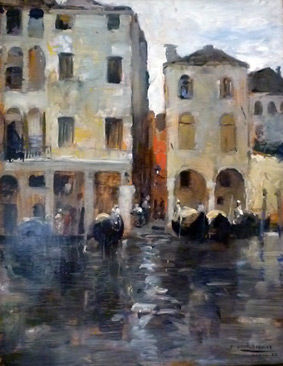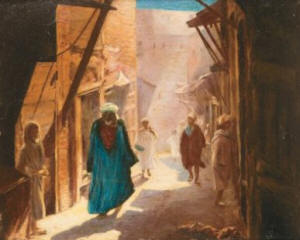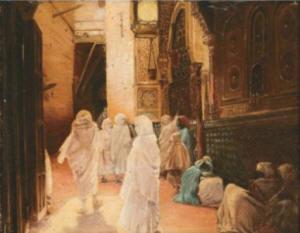::
CATALOGUE RAISONNÉ
L'objectif de ce catalogue raisonné consiste à dresser un inventaire
d’œuvres et de leur localisation afin de répertorier la production de Joseph
Saint-Germier et documenter ainsi chacune des œuvres avec des informations
techniques (thème, dimensions, technique, datation, ...) et historiques
(propriétaire, localisation, exposition, vente, …).
Ce projet cherche également à constituer une
monographie approfondie du peintre considérant des aspects tels que : sa
généalogie et sa biographie, sa formation académique, ses influences, ses
choix et ses évolutions stylistiques, ses collègues et ses éventuels élèves,
le regard porté par la critique et le grand public.
L'approche de cet étude s'organise à partir d'un
critère chronologique selon lequel seront classées les œuvres. Pour ce
faire, nous envisageons un plan de travail d'une durée de deux ans, à partir
de septembre 2013 jusqu'à 2015. Ce travail sera renforcé par une série de
recherches sur place (Paris, Toulouse, Rome, Venise, Bordeaux, Pau, …) et
des échanges avec des institutions et des chercheurs européens et
internationaux.

Saint-Germier, Joseph. Un canal à Venise, 1888, huile sur toile. Collection M. F. Saint-Germier. Photographie Ch. Dujour ©
Avec cette
recherche nous voulons non seulement remettre en lumière l’œuvre de Joseph
Saint-Germier mais aussi contribuer à l'étude de l'histoire de la peinture
du XIXe siècle et tenter de répondre à des questions comme : la
photographie, qui supplantera progressivement la peinture dans sa fonction
de représentation, a-t-elle eu une incidence dans la perception du peintre ?
Comment s'affirme-t-il en tant que peintre académique dans une époque où les
mouvements et les écoles se multiplient fascinés par les promesses que le
progrès semble ouvrir pour l'avenir ? Et dans le plan du progrès industriel
et modernisateur qui suscite la fascination d'un nombre important de
peintres privilégiant le plein-air et les vues urbaines, comment justifier
l'intérêt de Saint-Germier pour l'exotisme et les paysages (hormis Venise)
ruraux, vernaculaires ? Comment accepter que la figure de cet artiste soit
tombée dans l'oublie de l'histoire de la peinture, soit si inconnu du
public ? Et finalement, quelle est la contribution et l'importance de la
peinture de Joseph Saint-Germier à l'histoire de son époque et à l'histoire
de l'art ?
:: CATALOGUE RAISONNE
The aim of this catalogue raisonne is to establish an
inventory of works and their location in order to index the production of
Joseph Saint-Germier and to reference like this, each of the works with
technical informations ( theme, dimensions, technique, date,....) and
historic informations (owner, location, exhibition, sale, …).
This project of research also aims to draw up a
detailed monograph of the painter by taking in consideration aspects such
as: his genealogy and his biography, his academic education, his influences,
his stylistic choices and evolutions, his colleagues and possible students,
the view of the critics and the general public.
The approach of this study is organised from a
chronological criterion in which the works will be classified. In order to
do this, we envisage a work plan for a period of two years from September
2013 until 2015. This work will be reinforced by a series of researches on
site ( Paris, Toulouse, Rome, Venice, Bordeaux, Pau, …) and some exchanges
with the institutions and European and international researchers.
With this research, we don't wish only to bring back
to light the work of Joseph Saint-Germier, but we also want to contribute to
the study of the history of the painting in the 19th century and to try to
answer some questions like: Does the photography, which will gradually
replace the painting in its role of representation, have a repercussion in
the perception of the painter? How does he establish himself as an academic
painter in a time where the movements and schools increase fascinated by the
promises that the progress seems to create for the future? And in the
project of the industrial and modernizing progress that arouse the
fascination of a great number of painters who privilege the outdoor and
urban views, how can we justify the interest of Saint-Germier for the
exoticism and the landscapes that are – except for Venice - rural and
vernacular? How can we accept that the figure of this artist has faded from
the memory of the history of painting, and that he is so unknown to the
public? And finally, What is the contribution and the importance of the
painting of Joseph Saint-Germier in relation to the history in his time and
ours?


Saint-Germier, Joseph. Fez, Mosquée de Moulaye Idriss, le mur des offrandes and Rue animée, Fez , 18.., Oil on cardboard . Collection M. F. Saint-Germier. Photography Ch. Dujour ©